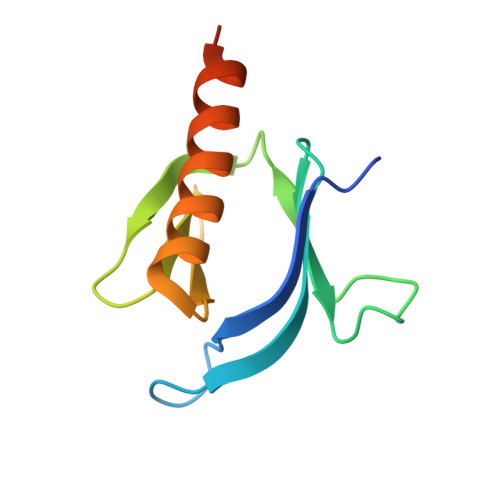Structural Insights Uncover the Specific Phosphoinositide Recognition by the PH1 Domain of Arap3.
Zhang, Y., Ge, L., Xu, L., Liu, Y., Wang, J., Liu, C., Zhao, H., Xing, L., Wang, J., Wu, B.(2023) Int J Mol Sci 24
- PubMed: 36674645
- DOI: https://doi.org/10.3390/ijms24021125
- Primary Citation of Related Structures:
7YIR, 7YIS - PubMed Abstract:
Arap3, a dual GTPase-activating protein (GAP) for the small GTPases Arf6 and RhoA, plays key roles in regulating a wide range of biological processes, including cancer cell invasion and metastasis. It is known that Arap3 is a PI3K effector that can bind directly to PI(3,4,5)P3, and the PI(3,4,5)P3-mediated plasma membrane recruitment is crucial for its function. However, the molecular mechanism of how the protein recognizes PI(3,4,5)P3 remains unclear. Here, using liposome pull-down and surface plasmon resonance (SPR) analysis, we found that the N-terminal first pleckstrin homology (PH) domain (Arap3-PH1) can interact with PI(3,4,5)P3 and, with lower affinity, with PI(4,5)P2. To understand how Arap3-PH1 and phosphoinositide (PIP) lipids interact, we solved the crystal structure of the Arap3-PH1 in the apo form and complex with diC4-PI(3,4,5)P3. We also characterized the interactions of Arap3-PH1 with diC4-PI(3,4,5)P3 and diC4-PI(4,5)P2 in solution by nuclear magnetic resonance (NMR) spectroscopy. Furthermore, we found overexpression of Arap3 could inhibit breast cancer cell invasion in vitro, and the PIPs-binding ability of the PH1 domain is essential for this function.
Organizational Affiliation:
High Magnetic Field Laboratory, Key Laboratory of High Magnetic Field and Ion Beam Physical Biology, Hefei Institutes of Physical Science, Chinese Academy of Sciences, Hefei 230031, China.















